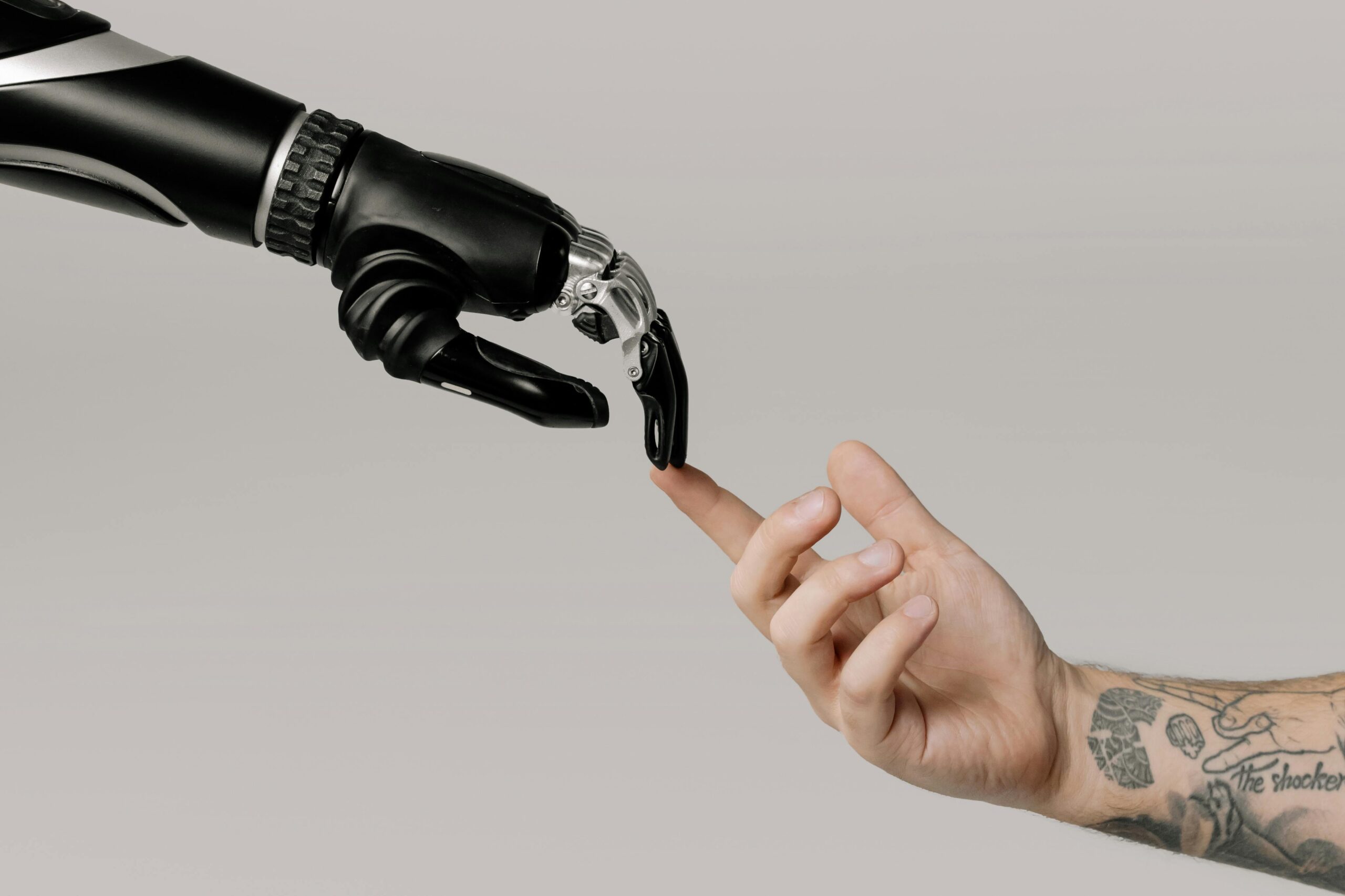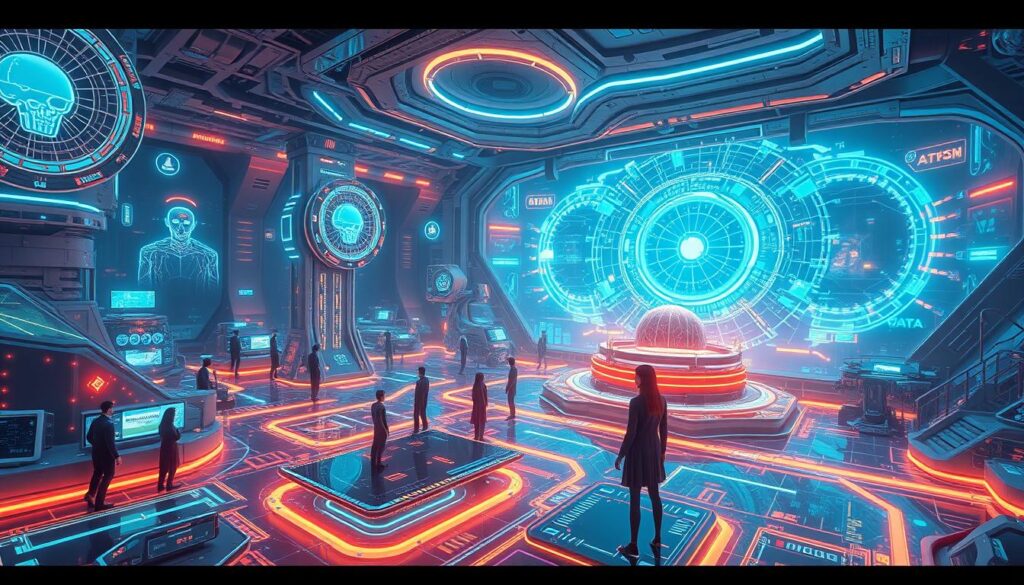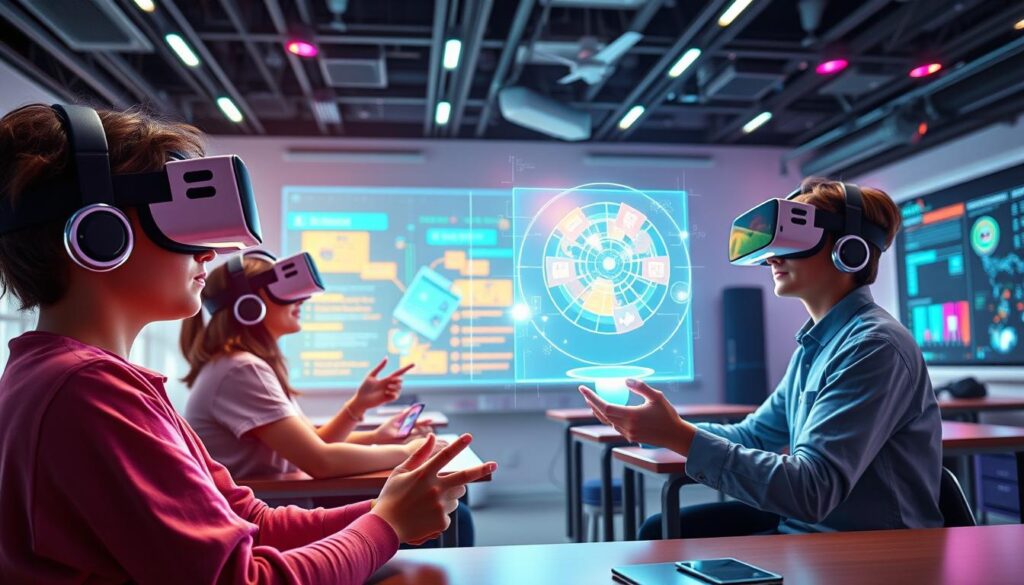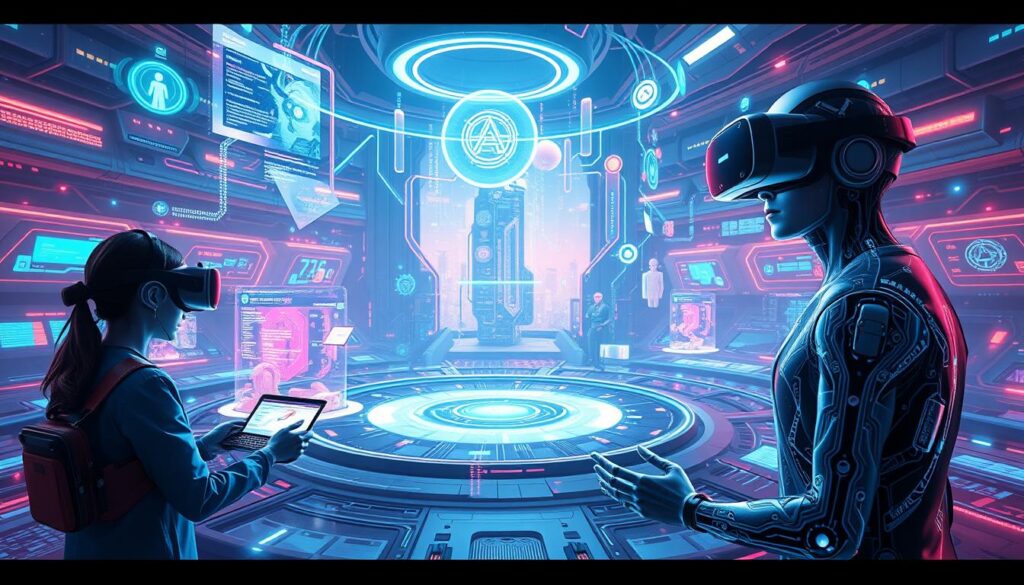Physical Address
304 North Cardinal St.
Dorchester Center, MA 02124
Physical Address
304 North Cardinal St.
Dorchester Center, MA 02124

The mix of virtual reality and AI is changing how we use technology. It’s making our experiences more real and fun. This new tech is set to change many fields, like gaming, healthcare, and education.
As we dive into virtual reality with AI, it’s key to know the tech behind it. This future tech will change many areas, from fun to learning. It will all be thanks to immersive tech and virtual reality with AI.

AI in virtual reality makes things more fun and real. Users can play with virtual things in a natural way. This is what makes immersive technology so cool.
The mix of artificial intelligence and VR is growing fast. It’s changing many fields. AI in VR uses machine learning, natural language, and computer vision. This makes virtual worlds more real and fun.
AI-VR has key parts like data handling, sensor use, and feedback. These help with fast rendering, dynamic scenes, and personal interactions. For example, computer vision makes virtual objects feel real. Machine learning makes games adjust to your skill level.
To get AI-VR, you need to know the basics. It’s about AI making virtual worlds feel real. And how we can dive into these worlds in a deep way.
The main parts of AI-VR are:
AI makes VR better by adding real-time effects and personal touches. This makes our virtual adventures more exciting. It’s changing gaming, learning, and health care.
VR and AI together are changing many areas. It’s key to know how these techs work and what they do. With AI in VR, we’re making virtual worlds that change how we live, work, and play.
Virtual reality experiences with AI are getting more popular. They’re used in gaming, entertainment, and education. The mix of AI and VR makes experiences more real and fun. Immersive technology has grown a lot, with big steps forward in VR, AR, and MR.
Immersive tech is still growing. We’ll see better VR and AI soon. Some big areas to watch include:
As AI and VR keep getting better, we’ll see new uses. This tech could change many industries and how we use technology. The future of immersive tech is exciting and fast-changing.
| Technology | Description |
|---|---|
| VR | Virtual reality technology that creates immersive experiences |
| AR | Augmented reality technology that overlays digital information on the real world |
| MR | Mixed reality technology that combines elements of VR and AR |
The mix of artificial intelligence and virtual reality has led to ai-powered virtual reality that’s more real and fun. At the center of this tech are key parts that make virtual reality applications of ai work. Knowing these core technologies helps us see the full potential of ai-powered virtual reality.
Important technologies include machine learning, neural networks, and computer vision. They help make experiences that fit you, look real, and move with you. For example, machine learning in VR adjusts to how you act, making it more fun.
These technologies have many uses. Some main areas for virtual reality applications of ai are:
As ai-powered virtual reality gets better, we’ll see more cool uses of these technologies. The future of virtual reality applications of ai looks bright, with lots of chances to change how we use technology.
The use of ai in vr development has changed the gaming and entertainment worlds. It has made virtual environments more immersive and interactive. Developers can now create experiences that feel real and are tailored to each user.
Some key uses of ai in vr development include:
ai in vr development has also made virtual worlds more realistic. This technology is used in education, healthcare, and entertainment. As it keeps improving, we’ll see even more exciting uses of ai in vr.
For instance, ai-powered virtual reality platforms can offer interactive and immersive experiences. These can be virtual reality games or simulations. They also create virtual environments that adapt to how users interact with them.
In summary, ai in vr development is changing the gaming and entertainment industries. It’s making experiences more immersive, interactive, and engaging for users.
| Application | Description |
|---|---|
| Gaming | Personalized gaming experiences, with ai-powered systems adjusting difficulty levels and gameplay in real-time |
| Simulation | Interactive storytelling, with ai-driven characters and plotlines that respond to user input |
| Education | Virtual reality simulations, with ai-generated environments and scenarios for training and education |
Artificial intelligence has changed healthcare and medicine a lot. It makes virtual reality better and more real. This is great for many uses.
AI helps make patient care, medical education, and research better. For example, surgeons can practice complex procedures in a virtual space. This lowers the chance of mistakes and boosts their skills.
AI and virtual reality are big in surgical training. Surgeons can get better at their jobs in a real-like setting. This is thanks to AI.
AI and virtual reality also help with mental health. They treat anxiety and PTSD by exposing patients to safe, fake environments. This helps them face their fears.
| Application | Description |
|---|---|
| Surgical Training | Practice and refine surgical skills in a virtual environment |
| Mental Health Treatment | Treat mental health disorders such as anxiety and PTSD using simulated environments |
| Rehabilitation Programs | Help patients recover from injuries or illnesses using personalized and adaptive virtual environments |
The mix of artificial intelligence in VR is changing education. It brings immersive tech that makes learning better. Students can now dive into complex topics in a fun and interactive way.
Some big pluses of using VR in schools are:
VR with AI also helps create smart tutoring systems. These systems can change to fit each student’s needs. This tech could change how we teach and learn, making education better for everyone.

As VR and AI in education grow, we’ll see big changes. Teachers can now make learning fun and interactive. This means students get a better education.
AI in virtual reality is changing how businesses work. It lets companies create interactive virtual spaces for many uses. This is especially useful for training employees.
With AI, businesses can offer personalized training. This makes learning more effective and fun. Employees learn better and faster.
AI in virtual reality brings many benefits to businesses. It makes training more engaging and interactive. It also helps teams work better together, even when they’re apart.
Businesses are seeing big improvements in how they work. They’re using virtual reality to make processes more efficient. This is thanks to digital twin technology.
As AI in virtual reality grows, so will its uses. It’s changing how businesses interact with their teams and customers. This technology is making a big impact.
Businesses that use AI in virtual reality are ahead of the game. They’re using it for training, teamwork, and more. The future looks bright for these companies.
AI in virtual reality has led to new ways to interact and communicate. It makes virtual environments more real and engaging. This is great for virtual events, remote meetings, and social networking.
Some key benefits of ai-powered virtual reality in social interaction and communication include:
Ai-powered virtual reality is changing how we interact and communicate. It offers new ways to connect with others. This technology makes our interactions more personal and adaptive.
As ai-powered virtual reality gets better, we’ll see more new uses. It’s creating virtual spaces that feel real and interactive. This technology is set to change how we connect and interact with the world.
| Application | Description |
|---|---|
| Virtual Events | Ai-powered virtual reality enables the creation of realistic and interactive virtual environments for events, such as conferences and meetings |
| Remote Meetings | Ai-powered virtual reality enables remote meetings and collaboration, enhancing productivity and efficiency |
| Social Networking | Ai-powered virtual reality enables new and innovative forms of social interaction and communication, such as virtual social networks and communities |
As virtual reality applications of ai grow, we face many technical hurdles. One big issue is the need for lots of processing power. This is a problem for many devices.
Some of the key issues that need to be overcome include:
Despite these challenges, new VR and AI technologies are being developed. These advancements will help solve these technical problems. This will make virtual environments more immersive and interactive.
The integration of ai in vr development is set to change many industries. This includes gaming, healthcare, and education. It will bring new virtual reality applications of ai.

By tackling these technical challenges, developers can unlock ai’s full potential in VR. This will create immersive experiences that change how we interact with virtual worlds.
| Technical Challenge | Solution |
|---|---|
| Processing Power Requirements | High-performance processors |
| Latency Issues and Solutions | Optimized software and hardware solutions |
| User Interface Optimization | Intuitive and user-friendly interfaces |
As vr innovations with artificial intelligence grow, we must talk about privacy and security. AI in VR brings up big questions about keeping user data safe and making virtual spaces secure.
Some important things to think about are:
As vr innovations with artificial intelligence get better, we can tackle these issues. This will help make virtual spaces safer and more private. By focusing on privacy and security, we can make sure these technologies are used right and help everyone.
The future of virtual reality with AI looks bright. New tech like augmented reality and mixed reality will make virtual worlds more real and fun. These advancements will change how we interact with digital spaces.
As immersive technology gets better, we’ll see more experiences tailored just for us. AI in VR will make a big difference in gaming, learning, and health care. It will make these areas more engaging and effective.
New tech will team up with virtual reality with AI to bring us fresh experiences. As tech keeps improving, we’ll see new ways to use it in our lives.
We’re expecting AI in VR to make experiences more personal and smart. This will be huge in health care. Virtual reality with AI can help create custom treatment plans and therapy sessions.
Experts think the VR and AI markets will keep growing. They’ll be used in gaming, learning, and health care. As immersive technology spreads, we’ll see new ways to make money and do business.
The mix of artificial intelligence (AI) and virtual reality (VR) has started a new chapter in immersive experiences. AI makes virtual worlds more real, flexible, and tailored to each person. This change is big in fields like gaming and healthcare.
But, there are still technical hurdles to overcome. Despite this, the future of AI in VR looks very promising.
By diving into this virtual world, we open up endless possibilities. AI in VR is changing how we learn, have fun, and even treat illnesses. As these technologies grow, they could make our social lives better, help us work more efficiently, and deepen our digital understanding.
The future of AI and VR is going to be thrilling. We’ll see more amazing things as these technologies come together. By keeping up with the latest in AI and VR, we can help shape the future of virtual experiences. Let’s dive into this new world with curiosity and a desire to learn.
The main technologies behind AI-powered VR are machine learning, neural networks, and computer vision. These help make virtual worlds more real and interactive. They also make experiences more personal and the visuals more detailed.
AI changes virtual experiences by making them more real-time and interactive. It creates environments that adapt to how you behave and what you like. This makes your virtual world more immersive and personal.
AI in VR is used in healthcare for training surgeons, treating mental health, and helping with rehabilitation. It makes these experiences more realistic and interactive. This helps in many medical fields.
AI in VR makes social interactions more real and fun. It’s used for virtual events, meetings, and social networking. AI tailors these experiences to fit your behavior, making them more personal.
New technologies like augmented and mixed reality will shape VR’s future with AI. We can expect more personalized and adaptive experiences. The VR industry is also expected to grow in gaming, education, and healthcare.
Challenges include needing more processing power and dealing with latency and user interface issues. Advances in hardware and software aim to solve these problems. This will make VR experiences more seamless and immersive.
Using AI in VR raises privacy and security concerns. Virtual worlds can collect and use your data. It’s crucial to protect your data and ensure the security of these virtual spaces as VR and AI evolve.